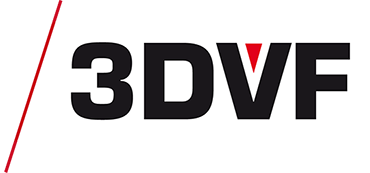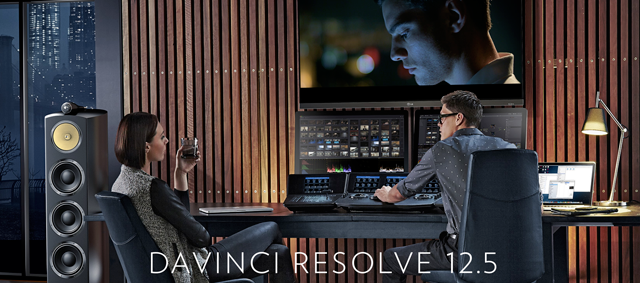Blackmagic, bien connu pour sa gamme de camera, vient d’annoncer au NAB le lancement d’une mise à jour de son logiciel de montage et d’étalonnage DaVinci Resolve.
Disponible dès à présent pour Windows et OS X, l’éditeur annonce que cette mise à jour DaVinci Resolve 12.5 beta contiendrait plus d’un millier d’améliorations et plus de 250 nouvelles fonctions.
Parmi ces nouveautés, on notera surtout l’arrivé de nouveaux outils de retouches HDR, une accélération GPU optimisée ainsi qu’une connexion temps réel avec Fusion, son logiciel de compositing racheté il y a quelques années pour compléter sa gamme.
Voici la liste et le détail des principales nouveautés apportées dans cette version 12.5 (en anglais) :
Editing tools
DaVinci Resolve 12.5 adds dozens of new editing and trimming features such as new swap and shuffle edits, seven entirely new trim operations, paste inserts, an expanded edit overlay with ripple overwrites and append edits, and much more. In addition, timeline performance has been greatly improved so editing is faster and the new Cinema Viewer option plays video full screen, making it easier for customers to preview their cut on laptops or systems with a single display.
Navigate clips using audio waveforms
DaVinci Resolve 12.5 introduces an entirely new way to navigate clips using audio waveforms. The source viewer features a revolutionary audio waveform overlay that allows you to see the audio waveform and video clip at the same time. This is the fastest way to navigate to different parts of a clip based on spikes, silent areas or other visual cues in the audio waveform.
Media management
DaVinci Resolve 12.5 also adds dozens of new media management and metadata features that make it easier for both assistants and editors to organize and work with massive amounts of media. A new metadata keyword dictionary makes it easier to choose common or previously created keywords and quickly apply them to clips. Metadata can now also be imported or exported via CSV files. Media Pool metadata columns can also be customized and saved, colors can be assigned to specific clips, and markers can now be single frame or durational. Display names, which are used throughout the software, can be automatically created based on metadata tags such as scene, shot and take information, saving editors hours when importing and working with large amounts of footage. New Power Bins in the Media Pool allow sharing of content between projects, making them perfect for graphics, stock footage and sound effect or music libraries used across multiple projects.
Retiming
DaVinci Resolve 12.5 introduces an entirely new way to create custom retime effects and speed ramps. There are now separate curves for both frame position and playback speed. This allows any frame to be moved to any point in time, while also allowing variable speed changes between any range of frames. These powerful new controls make it easier to create unique retiming effects that were never possible before.
Curve editor
The timeline curve editor has been improved so customers can now select, move, and edit groups of multiple keyframes at the same time. There are also new visual controls for adding or selecting keyframes, as well as a menu for selecting specific parameters and curves to edit.
Grading tools
For colorists, DaVinci Resolve 12.5 introduces major enhancements to the node editor so now it’s possible to quickly navigate between nodes, swap nodes, select multiple nodes with a lasso, copy node contents, extract nodes, use embedded alpha channels in mattes and more. When dragging a saved grade from the gallery, customers now have the option to drag the grade in as a single compound node, or as a fully expanded node tree. These changes allow professional colorists to work even faster, while also making it more intuitive for video editors that are learning how to use Resolve’s massive set of color correction tools. In addition, there is a new single point tracker, new temperature and tint sliders have been added to the primary grading controls, additional XRite Colorchecker charts are now supported in the Color Match palette and customers can now select and modify multiple control points at the same time when working with Power Curve Windows.
Support for HDR footage
With cameras such as Blackmagic Design’s URSA Mini 4.6K that already shoot with the latitude needed for HDR work, DaVinci Resolve 12 has already been used to grade more HDR content than any other system. DaVinci Resolve 12.5 Studio now includes major advances in HDR grading controls. Specific nodes can now be set to HDR mode which enables the grading tools in Resolve to work in an extended dynamic range especially designed for HDR deliverables such as Dolby Vision and HDR10. In addition, caching formats such as ProRes 4444 XQ and DNxHR now support extended dynamic range to serve as an efficient storage alternative to uncompressed 16-bit float files. These enhancements mean Blackmagic Design is the only company that offers a complete end to end HDR workflow from on set production to post production.
ResolveFX: GPU-accelerated effects framework
DaVinci Resolve 12.5 also introduces ResolveFX, a powerful new framework for native GPU and CPU accelerated effects. This release includes ResolveFX plug-ins such as GPU accelerated color space and gamma transformations, along with more traditional effects such as lens blur, light rays, emboss, dent, vortex, mirrors, gaussian and other blurs, glows, ripples, and more. Advanced ResolveFX tools like film grain, lens blurs and flares are available with DaVinci Resolve 12.5 Studio.
Fusion Connect: live link to Fusion
For more advanced visual effects work, the new Fusion Connect feature lets customers send clips to Fusion for additional visual effects. Fusion is Blackmagic Design’s advanced node based 3D compositing, visual effects and motion graphics software. When scenes are rendered out of Fusion, they automatically replace the clips on Resolve’s timeline. As effect shots are completed, the Fusion Connect clips in the Resolve timeline can be refreshed to show the most current version of the shot.
Export options
The Deliver page (above) has been completely redesigned so now it’s easier to find presets, customize render settings and organize jobs. The new icon browser lets customers see and select output presets which include a new Premiere Pro export, along with presets for ProTools, Avid, Final Cut Pro, Vimeo, YouTube and more. In addition, audio can now be output independently of video as single or multichannel, and clips can be exported with an alpha channel when using supported codecs such as ProRes 4444, ProRes 4444 XQ and uncompressed RGBA.
Automated noise reduction and lens correction
In addition to all of the above features, DaVinci Resolve 12.5 Studio customers will also get dramatically improved spatial noise reduction which uses a superior multi GPU accelerated algorithm to reduce noise while retaining incredible detail. When combined with DaVinci Resolve 12.5’s enhanced temporal noise reduction controls, customers get the ultimate noise reduction toolset. DaVinci Resolve 12.5 Studio customers also get a new automatic correction tool for fixing barrel, pin cushion or perspective lens distortion, along with high quality de-interlacing, support for Camera LUTs, the DaVinci Color Transform Language (.dctl), and the ability to create ProRes remote render jobs on Windows machines. Customers can even use a terminal command to run a headless version of DaVinci Resolve without the GUI for remote rendering.




